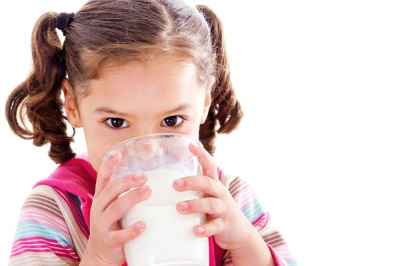From how many months can you give baby kefir?
Kefir is a popular representative of dairy products, so it is recommended for baby food. When is it worth introducing toddler with him and how to introduce this product into the baby’s diet?
pros
- It acts as a source of a large number of useful nutrients, among which are not only proteins and vitamins, but also lactic acid bacteria. It is a valuable product for anemia, as well as for rickets.
- Its use creates an acidic environment in the baby’s stomach, which helps to quickly assimilate various nutritional components of food, in particular, calcium and vitamin D.
- Its use has a beneficial effect on the intestinal microflora.
- A child who is given kefir improves his appetite and strengthens his immunity.
- Due to the partial hydrolysis of proteins in such a dairy product, it can be consumed by babies who are allergic to milk. Also, this product is recommended for lactase deficiency.
- It contains lactic acid, which is excellent. antiseptic.
- He noted a positive effect on the nervous system. It soothes, tones and helps eliminate fatigue.
- In fresh (one-day) kefir, a laxative effect is noted, and for a product that was made two days ago and more, the effect, on the contrary, will be fixative.
Minuses
Introduced into the diet too early, kefir will put a significant burden on the kidneys and the digestive system of the baby. In addition, carbohydrates and fats presented in the composition are quite different from these components in the mixture or breast milk.
- Since it is rich in casein, its digestion can be difficult in a child’s body.
- Many babies refuse this useful product because of its taste properties.
- It is not recommended for frequent diarrhea and high acidity of gastric juice.
Possible adverse reactions
In some children, kefir causes intolerance, which can be manifested by nausea, fever, vomiting, abdominal pain of a spastic nature, rash, runny nose, sneezing, redness on the skin and other symptoms. In addition, if storage conditions are not met and an expired product has got to the child, it can cause food poisoning.
From what age is it better to give?
There is no general opinion about the age when you can start giving kefir to the baby. In various sources, mothers see recommendations about introducing him into the children's diet from six months to a year. Most often, infants fed with her mother's milk are offered from the age of eight months, and an artificial-fed infant is given this fermented milk product a little earlier - from seven months. By this age, the infant’s intestines mature, so digestion problems usually do not appear.
Opinion of Dr. Komarovsky
The famous pediatrician recommends starting to give kefir to babies at 6 months, as the first complementary food, explaining that it is more similar to fermented milk products with a child’s nutrition up to six months than vegetable and fruit dishes. A popular doctor recommends introducing it into the baby’s menu at the second feeding, starting with a 15-20 ml serving. Gradually increasing the portion, from the fifth day you can begin to add cottage cheese to it.
Concerning the harm of kefir, Komarovsky reminds that this product has long been used for feeding in our country. Harmful effects not confirmed by medical research. So parents shouldn’t worry if they don’t feed the child exclusively with this product and do not introduce it into the baby’s diet before 6 months of age. Categorical contraindications for the use of crumbs is only an early age, as well as a clear allergy to this product.

Enter into the diet
Like all other complementary foods, kefir should be introduced into the children's diet gradually. The first portion will be one teaspoon of the product. Give it to be in the morning. In the absence of a negative reaction, the portion is doubled every day until the total volume is adjusted to the age.
In what form can I give?
Kefir, which is given to a child, must be at room temperature. It can be given both from a spoon and from a small cup.
If the baby does not like it as a separate product, it can be mixed with a banana, apple or other fruit puree. However, you should try to avoid adding fruit juices, as they are capable of neutralizing lactic bacteria.
How to choose?
It is advisable not to give baby kefir, which is sold in the store, if there is no mark on it that it is a child product. Optimally, if the mother will cook it for the baby with her own hands. However, if you still have to buy the kefir that adults usually consume, then it is important to read its composition and make sure that there are no foreign harmful additives in the product.
In addition, for children should take fresh natural kefir, so when buying, make sure that the product has a minimum shelf life. As for fat, children usually give a product with a mark of 2-3% fat.
Recipe for cooking at home
Mom can use special starter culture, adding them according to the instructions in the milk. Also, as a starter, you can use the store yogurt.
One spoon of the product is stirred in a glass of milk, which must be boiled and cooled beforehand (you can also dilute the milk 2: 1 with water) and leave it for 9-12 hours in a thermos or other warm place. It is best to cook it in the evening, then the next day you can give it to the crumbs in one of the morning feedings. Within two days, the resulting new kefir can be used as a starter for a new portion of the product.
Useful tips
- If you give kefir to your baby in the morning, then recharge the baby with vigor for the whole day. A portion drunk at night will help improve sleep.
- Keep it at home should be in the refrigerator. It is best to give the baby a product immediately after cooking or purchasing.
- You can give it to babies daily, but experts consider it optimal to feed children with this fermented milk product 2-3 times a week.
- A kid who categorically opposes the introduction of kefir in the diet, you can mix the drink with fruit or give to him biscuit. If the crumb still persists, postpone the introduction of this product in the children's menu for a while or replace it with another version of fermented milk foods.






























































